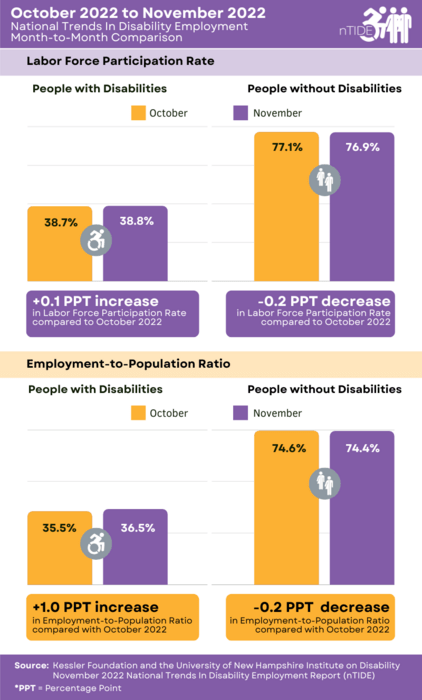East Hanover, NJ – December 2, 2022 – Job numbers rose again for people with disabilities, in contrast to people without disabilities, according to today’s National Trends in Disability Employment – Monthly Update (nTIDE), issued by Kessler Foundation and the University of New Hampshire’s Institute on Disability (UNH-IOD). People with disabilities continued to show strength in the labor market in November, as evidenced by the substantial rise in their employment-to-population ratio.
Month-to-Month nTIDE Numbers (comparing October 2022 to November 2022)
Based on data from the U.S. Bureau of Labor Statistics (BLS) Jobs Report released today, the employment-to-population ratio for people with disabilities (ages 16-64) increased from 35.5 percent in October to 36.5 percent in November (up 2.8 percent or 1 percentage point). For people without disabilities (ages 16-64), the employment-to-population ratio decreased from 74.6 percent in October to 74.4 percent in November (down 0.3 percent or 0.2 percentage point). The employment-to-population ratio, a key indicator, reflects the percentage of people who are working relative to the total population (the number of people working divided by the number of people in the total population multiplied by 100).
“Similar to last month, the employment-to-population ratio for people with disabilities increased and remains above historic highs. For those without disabilities, however, the ratio dropped,” said John O’Neill, PhD, director of the Center for Employment and Disability Research at Kessler Foundation. “This decline may be a sign of the Fed’s efforts to slow the labor market. This is interesting in light of this month’s strong gain for people with disabilities.”
Findings were similar for November’s labor force participation rate. For people with disabilities (ages 16-64), the labor force participation rate was increased slightly from 38.7 percent in October to 38.8 percent in November (up 0.3 percent or 0.1 percentage point). Conversely, the labor force participation rate decreased slightly for people without disabilities (ages 16-64), from 77.1 percent in October to 76.9 percent in November (down 0.3 percent or 0.2 percentage point). The labor force participation rate is the percentage of the population that is working, not working, and on temporary layoff, or not working and actively looking for work.
“While labor force participation for people with disabilities remains stable, increases in the employment to population ratio for people with disabilities suggest that more people with disabilities are succeeding in finding jobs,” remarked Debra Brucker, PhD, research associate professor at the UNH-IOD. “Keep in mind that gains in employment may in part reflect the need to boost income in the face of rising prices. Also, these data are not seasonally adjusted, so some of this increase may be due to seasonal employment.”
Why have people with disabilities been outperforming people without disabilities? Favorable changes in the workplace as employers adapted to COVID-19 restrictions may be a factor. Our new survey compares the workplaces of 2017 and 2022, revealing gains in recruiting, hiring, accommodating, and retaining employees with disabilities. Read more about the 2022 National Employment & Disability Survey: Effects of COVID-19 Pandemic Supervisor Perspectives.
Year-to-Year nTIDE Numbers (Comparing November 2021 to November 2022)
Reflecting the continued strength of the employment of people with disabilities over the course of the year, the employment-to-population ratio for working-age people with disabilities increased substantially from 34.6 percent in November 2021 to 36.5 percent in November 2022 (up 5.5 percent or 1.9 percentage points). However, the employment-to-population ratio increased slightly for working-age people without disabilities, from 73.8 percent in November 2021 to 74.4 percent in November 2022 (up 0.8 percent or 0.6 percentage points).
Similarly, for people with disabilities (16-64), the labor force participation rate increased substantially from 37.7 percent in November 2021 to 38.8 percent in November 2022 (up 2.9 percent or 1.1 percentage points). The labor force participation rate increased slightly for people without disabilities (ages 16-64), from 76.7 percent in November 2021 to 76.9 percent in November 2022 (up 0.3 percent or 0.2 percentage points).
In November, among workers ages 16-64, the 5,962,000 workers with disabilities represented 4 percent of the total 148,009,000 workers in the U.S.
Ask Questions about Disability and Employment
Each nTIDE release is followed by an nTIDE Lunch & Learn online webinar. This live broadcast, hosted via Zoom Webinar, offers attendees Q&A on the latest nTIDE findings, provides news and updates from the field, as well as invited panelists to discuss current disability-related findings and events. On December 2, 2022 at 12:00 pm Eastern, Chai Feldblum, JD, vice chair the of Ability One Commission, a federal agency devoted to the employment of people with significant disabilities, joins Drs. O’Neill and Brucker, and Denise Rozell, Policy Strategist at the Association of University Centers on Disabilities (AUCD). Join our Lunch & Learns live or visit the nTIDE archives at: ResearchonDisability.org/nTIDE.
NOTE: The statistics in the nTIDE are based on Bureau of Labor Statistics numbers but are not identical. They are customized by UNH to combine the statistics for men and women of working age (16 to 64). nTIDE is funded, in part, by grants from the National Institute on Disability, Independent Living and Rehabilitation Research (NIDILRR) (90RT5037) and Kessler Foundation.
About the Institute on Disability at the University of New Hampshire
The Institute on Disability (IOD) at the University of New Hampshire (UNH) was established in 1987 to provide a university-based focus for the improvement of knowledge, policies, and practices related to the lives of persons with disabilities and their families. For information on the NIDILRR-funded Research and Training Center on Disability Statistics, visit ResearchOnDisability.org.
About Kessler Foundation
Kessler Foundation, a major nonprofit organization in the field of disability, is a global leader in rehabilitation research that seeks to improve cognition, mobility, and long-term outcomes – including employment – for people with neurological disabilities caused by diseases and injuries of the brain and spinal cord. Kessler Foundation leads the nation in funding innovative programs that expand opportunities for employment for people with disabilities. For more information, visit KesslerFoundation.org.
Stay Connected with Kessler Foundation
Twitter | Facebook | YouTube | Instagram | iTunes & SoundCloud
To interview an expert, contact:
Deborah Hauss, DHauss@kesslerfoundation.org;
Carolann Murphy, CMurphy@KesslerFoundation.org.








































